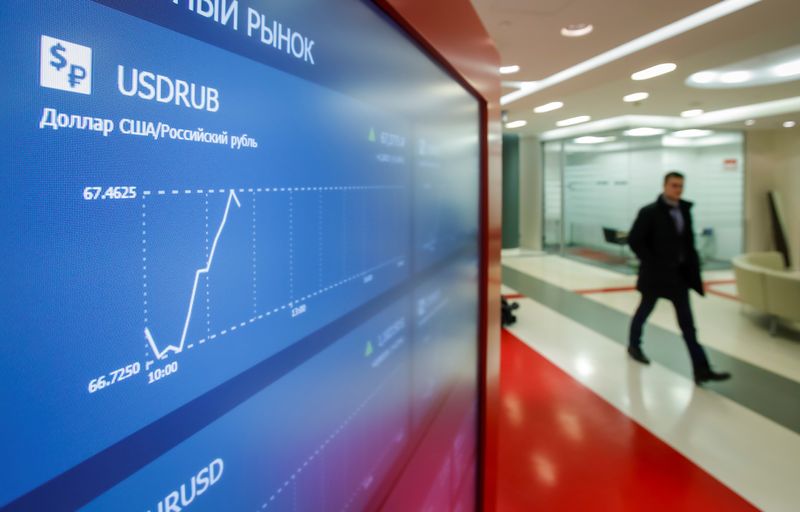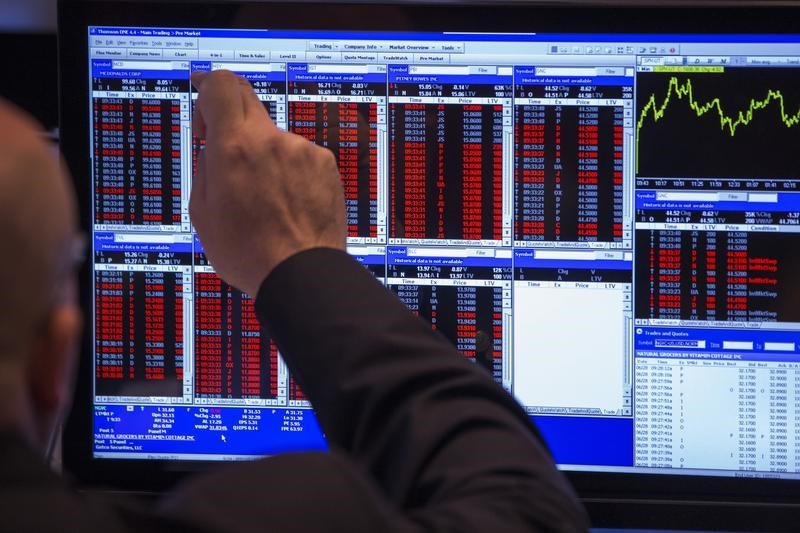By Alexander Marrow and Mark Trevelyan
(Reuters) -New U.S. sanctions on Russia have led to an immediate suspension of trading in dollars and euros on its main financial marketplace, the Moscow Stock Exchange.
The stock exchange and the central bank published statements on Wednesday – a public holiday in Russia – within an hour of Washington announcing a new round of sanctions aimed at restricting the flow of money and goods to support Russia’s war in Ukraine.
“Due to the introduction of restrictive measures by the United States against the Moscow Exchange Group, foreign exchange trading and settlement of deliverable instruments in US dollars and euros have been suspended,” the central bank said.
This move means that banks, companies and investors can no longer trade both currencies through a central exchange, offering liquidity, clearing and supervision benefits.
Instead, they will have to trade over-the-counter (OTC), where deals are made directly between two parties. The central bank said it would use OTC data to set official exchange rates.
Many Russians keep part of their savings in dollars or euros, taking into account the periodic crises of recent decades that have seen the ruble crash in value. The central bank assured people that these deposits were safe.
“Companies and individuals can continue to buy and sell US dollars and euros through Russian banks. All funds in US dollars and euros in the accounts and deposits of citizens and companies remain safe,” the report said.
One person at a major, non-sanctioned Russian commodity exporter told Reuters: “We don’t care, we have yuan. Getting dollars and euros in Russia is practically impossible.”
As Moscow pursues closer trade and political ties with Beijing, it has displaced the dollar to become MOEX’s most traded currency, accounting for 53.6% of all foreign exchange traded in May.
According to LSEG data, dollar-ruble trading volume on MOEX is around 1 billion rubles ($11 million) per day, while euro-ruble trading hovers around 300 million rubles per day. For yuan-ruble trading, daily volumes now regularly top 8 billion rubles.
WIDE SPREADS
On the eve of the national holiday, the ruble closed at 89.10 against the dollar and at 95.62 against the euro.
But after the sanctions news, some banks immediately increased their dollar rate.
Norvik Bank said it offered to buy dollars for just 50 rubles but sell them for 200 rubles, although it later adjusted the rates to 88.20/97.80. Tsifra Bank bought dollars for 89 rubles and sold for 120.
Other major banks recorded smaller spreads of 6 to 7 rubles between their buy and sell prices.
The US Treasury Department said it was “targeting the architecture of Russia’s financial system, which has been reoriented to facilitate investments in the defense industry and the acquisition of goods necessary to further aggression against Ukraine.”
The Russian central bank has been preparing for such sanctions for about two years. In July 2022, the bank said it was modeling various sanctions scenarios with forex market participants and infrastructure organizations.
“This is bad, but expected news,” Russian broker T-Investments said on Telegram.
Forbes Russia had reported in 2022 that the central bank was discussing a mechanism for managing the ruble-dollar exchange rate, should currency trading be halted in the event of sanctions on MOEX and its National Clearing Center, which was also hit by the new sanctions affected.
NERVE AHEAD ACT
MOEX said trading in shares and money market transactions settled in dollars and euros will also stop.
The sanctions will hit the exchange’s profits by cutting trading volumes. In May, total volume on MOEX reached 126.7 trillion rubles ($1.43 trillion), more than a third more than in the same month of the previous year.
In 2023, MOEX posted a net profit of 60.8 billion rubles, a year-on-year increase of 67.5%.
Yevegeny Kogan, an investment banker and professor at Russia’s Higher School of Economics, urged people not to panic.
“You know, it’s genetic for us – when we’re scared, we run away to buy currency. And it doesn’t matter if it’s 100, 120 or 150. You shouldn’t rush,” he warned people on Telegram, saying things could get very serious if people ignored that advice.

“Friends, it looks like tomorrow is going to be a very nerve-wracking day.”
($1 = 88.9955 rubles)


